les Nouvelles May 2015 Article of the Month
Advanced Citation Analysis Can Help Identify Licensing Candidates
Griffith Hack,
Consultant,
Melbourne, Victoria, Australia
Abstract
Citation analysis is used by many patent owners to search for potential licensing candidates, with many licensing managers reviewing forward citations for their patents to help find these candidates. In this paper we suggest some additional approaches that may also be useful. These include a statistical review of the forward citation patents, the Forward Rejection analysis available from Patent River, and the similarity and importance filters available in the AmberScope patent citation searching tool.
Many patent applicants will be very familiar with patent citations. For a patent to be granted it needs to be both novel and inventive over the prior art. While the exact definition of ‘novel’ and ‘inventive’ can vary between different jurisdictions, in almost every case the patent examination process includes a review of older published documents that may disclose similar subject matter to the claims of the patent application. These earlier published documents can be identified by a patent search run by the patent examiner, be based on a search conducted by another patent office examining the same application, or be submitted by the applicant either in the body of the patent specification or within an ‘Invention Disclosure Statement’ or similar document supplied by the patent applicant.
Published documents can include scientific papers, other documents and in the vast majority of cases will include earlier published patents. Prior art patents are so popular in search reports both because the patent literature is unusually well organised, catalogued and searchable, and also because the patent literature is so voluminous, with ca 2 million new patent publications every year.
These earlier published documents are often referred to as ‘backward’ or ‘reverse’ citations. Similarly, after a patent has been published it may be cited by later patents. Relative to the patent in question, these later patents are often referred to as ‘forward citations,’ as shown in Figure 1.

Both forward and backward citations can be very helpful to people reviewing the patent literature. Essentially each citation connection between two patents is an acknowledgment that an expert in the area (being a patent examiner or applicant) sees two patent as similar—or having overlapping subject matter. Given a relevant patent in any area, we can quickly identify similar patents simply by following patent citation connections.
Practically, these can be easily found on many patent search websites or subscription services. An example of this is shown in Figure 2 for the Google Patent search site, but there are many other sources of this data. These include Espacenet, Patentbuddy, the USPTO patent search site, and a number of paid patent search sites.
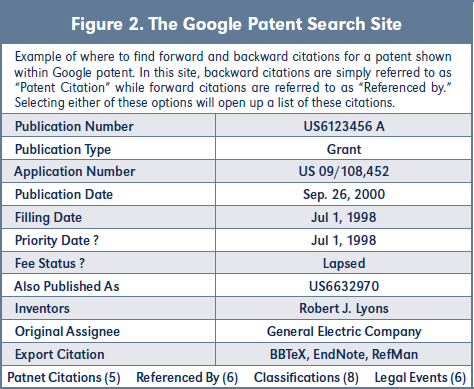
Forward citation connections can be particularly helpful to patent owners looking for potential licensing candidates. Later patent applicants who cite your patents in their patent applications may be using inventions claimed by your patent in their products and services. While patents per se do not infringe other patents, patent filings can provide useful information on the commercial intentions of the patent applicants, providing earlier patent owners with clues on where they should be looking for infringement. A conventional infringement analysis on products and services produced by the later patent applicants can then provide the information needed to determine if infringement is occurring.
Citation Patent Searching vs. Keyword and Patent Code Searching
The vast majority of patent searching is done using queries based on keyword or patent class codes. While undoubtedly useful, these technique can suffer limitations due to inconsistencies in selection of technical terms by different applicants for the same concept, and inconsistent application of patent class codes by different patent examiners or offices. In contrast, patent citations are nominated by either patent examiners or applications based on recognition of similarity, regardless of keyword or patent codes. Accordingly, the proportion of relevant patents for citation based patent searching can be in many cases higher than the proportion of relevant patents for a more conventional search.
Citation searching, like other forms of patent searching, is not perfect. Citation searching tends to be more effective for ICT and mechanical engineering patents than for pharmaceutical patents. U.S .patent examiners appear to have a bias to selecting U.S. based rather than foreign prior art, but the prior art patents listed on IDS statements may help to counter-act this bias. Regardless, citation searching can be a very useful addition to existing patent searching processes and help provide what can be a useful second opinion that avoids the risk of missing relevant patents due to what turns out to be erroneous assumptions about the best keywords or patent classes.
While these principles are generally well known, it can be time consuming for owners of large patent portfolios to make this objective review of their portfolio. Consider, for example patent US5343970 for a Hybrid Electric Vehicle, filed by Alex Severinsky and then assigned to the company he founded, Paice Corporation (and subsequently to a number of other assignees). While this patent has now expired, this patent was successfully asserted against Toyota including in the Federal Circuit. Paice had earlier settled with Ford over the same patent, but this litigation has recently restarted. Paice has also filed a suit against Hyundai and Kia, alleging that these two companies were infringing their patents.
As we might expect from a widely litigated patent that was one of the earliest patents in its field, this patent has been widely cited by later patents. The patent searching website Espacenet lists 326 forward patent citations.
This raises the question—if a patent analyst with-out specific information about an industry was asked to review these forward citations to suggest potential licensing partners, where would they start? Such a scenario is in fact surprisingly common, for example in the review of a patent portfolio that might be held by the likes of universities that may hold patents filed in a very broad range of subject areas.
There are in fact a series of techniques that allow the patent analyst to filter through such a large amount of forward citations. Some of the techniques may be familiar to some readers, but for some it will be new. To review these techniques, we will consider the Paice patent discussed above, and then a patent filed by Carnegie Mellon University which has been successfully litigated for over $1 billion dollars in damages.
We will discuss these techniques below in separate sections, first for Paice, consecutively for Carnegie Mellon. It should be noted that the examples shown are for illustrative purposes only. The value of an analysis such as this is that it can help to suggest who should be investigated. Any references to any companies owning forward citation patents in this article is not to imply in any way that these companies are infringing any patent discussed—instead only that the owners of the prior art patents might review the activities of these later patent filers as part of their general infringement investigation.
First Case Study—‘Paice Patent,’ US 5343970
a) General statistical review of citations.
Although it is more conventional to only look at forward citations in this sort of analysis, there are some good reasons to also review backward citations as well. Applicants for backward citation patents also have a proven interest in the technology and can be worth investigating for this reason.
Figure 3 shows that the filing of forward and backward patent citations peaked in the year 2002. There were relatively few backward citations.
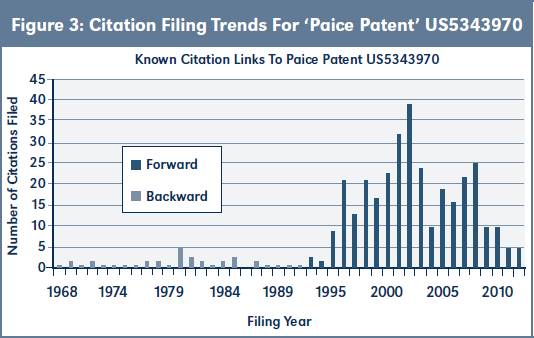
Figure 4 shows that Ford was by far the leading applicant of forward citation patents with 84 known citations, a long way ahead of Toyota and Aisin (a leading supplier of automotive parts, partly owned by Toyota). Toyota was unique in this list of top citers in that it also had a backward citation from the Paice patent. For a patent owner such as Paice, any of these leading companies would be worth investigating to see if any of their commercial products were infringing the ‘970 patent. It is worth noting that Paice has successfully completed litigation against both Ford and Toyota after asserting US5343970.
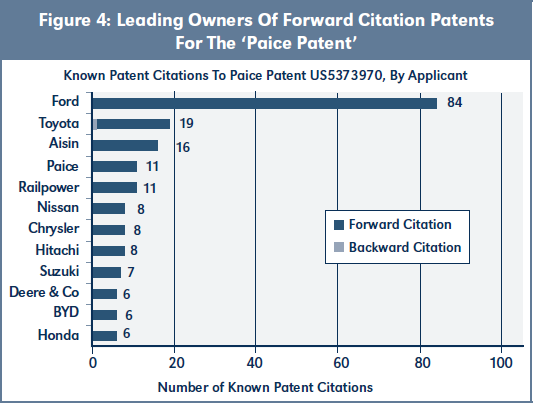
b) Identification of forward citation patents that refer to the subject patent in examiner’s reports (Patent River ‘Forward Rejection’ analysis).
As discussed earlier, citation links can be supplied by both patent applicants and patent examiners. While some analysts believe that backward citations supplied by patent applicants as part of their ‘Information Disclosure Statement’ (IDS) are of lower quality than examiner citations and should be ignored, we have seen plenty of evidence of highly relevant patent citations supplied by patent applicants.
Examiner patent citations can also be further classified according to whether they were specifically mentioned by the examiner in the examination report as either a reference to:
- The patent being examined lacking novelty in the light of the cited patent (e.g. section 102 of the U.S. patent code),
- Or a reference to the patent being examined lacking inventive step in the light of the cited patent (Section 103 of the U.S. patent code).
Patent data analysts Patent River (not affiliated with Ambercite) can supply lists of the forward citation patents from any nominated U.S. patent where these forward citation patents were specifically referred to by the examiner in either a novelty or obviousness objection. This can include citation references to patent applications that are subsequently abandoned—whereby these forward citation links may not be available in conventional databases. To help educate the readers of this article, Patent River has generously supplied this data for the Paice Patent.
These results are supplied in table form listing the individual objections. For the purpose of this paper, these results have been summarised in Table 1 below.
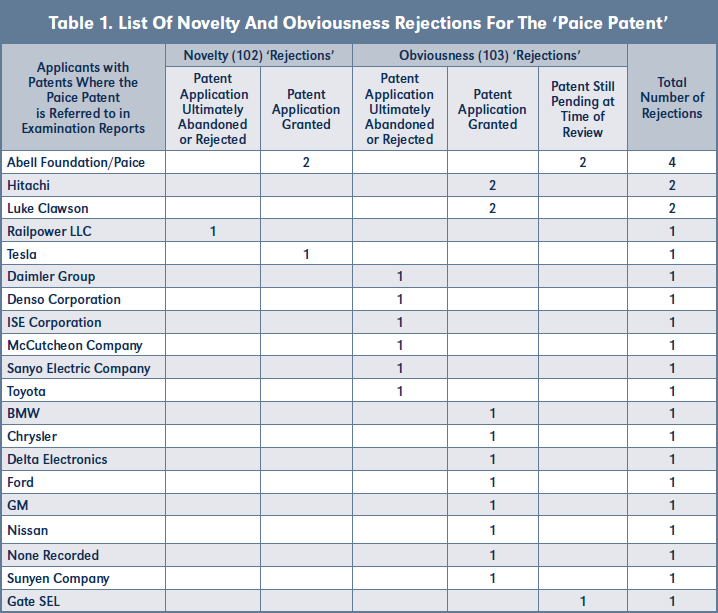
While technically the reference to an earlier patent in an examination report is more akin to an ‘objection,’ Patent River prefers to use the term ‘rejection’ for a direct reference in an examination report, and so the term ‘rejection’ will be used in the remainder of this paper.
Table 1 shows that:
- Abell Foundation (an investor in Paice) along with Paice were the most common patent owners to have the Paice patent cited against it. This is often seen in citation analysis, where an earlier patent of a patent owner is cited against later patents from the same owner.
- Hitachi and an individual inventor by the name of Luke Clawson each had the Paice patent cited against two of their patents.
- Railpower LLC and what became a Tesla patent each had the Paice patent cited against two of their patents in novelty rejections.
—The Tesla patent (abandoned after grant) was US7228925 and covered Electrical systems for electric powered vehicles, which referred to a voltage controller, an element found in some of the claims of the Paice Patent.
—The Railpower company patent was US20050206331, covering a Hybrid locomotive configuration, and which has now been abandoned. - Both novelty rejections have significant similarity between the Carnegie Mellon patent and the Seagate patent application.
For a patent owner such as Paice, any of these leading companies would be worth investigating to see if any of their commercial products were infringing the Paice patent. In addition, we might have a special focus on Tesla and Railpower as both companies had patent applications rejected for being too similar to (disclosed by) the Paice patent.
c) AmberScope analysis.
AmberScope has been developed by the patent analyst company Ambercite to visualise the network of patents connected to a patent of interest. Each network displays the backward and forward citations to a given patent, along with the interconnections between these cited patents. Moving a mouse over these citations opens up details of these citations. The size of each patent node governs the relative importance of a patent. There are options for manually classifying patents from 1 to 4, which changes the colour of the node of each patent and so can be used to highlight patents belonging to nominated patent owners.
The AmberScope patent network for the Paice patent is shown in Figure 5.
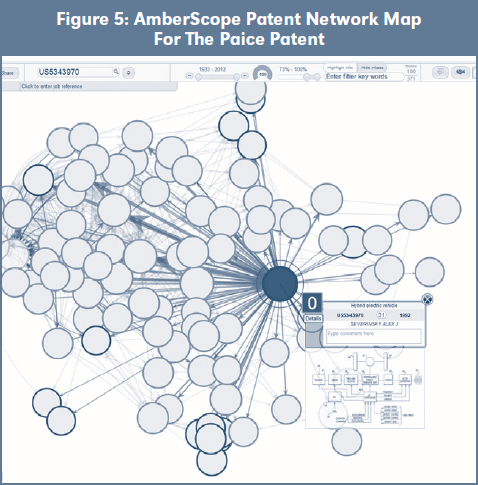
While for smaller patent networks a manual review of the patent network can help to quickly identify the most likely to be important connections, for a complex network such as this it can be hard to know where to start.
For this reason, AmberScope provides two filters to help this process.
i. A similarity filter.
Interconnections between the different cited patents can be used to predict the similarity between the ‘focus patent’ (the ‘970 patent in this case) and its connected patent. The similarity filter can be used to hide all but the most similar patents.
In Figure 6, the similarity filter has been combined with a filing year filter so that only the most similar 3 percent patents (seven patents in total) filed after 1993 are shown. The arrows point to the forward citations, i.e. patents that were filed later.
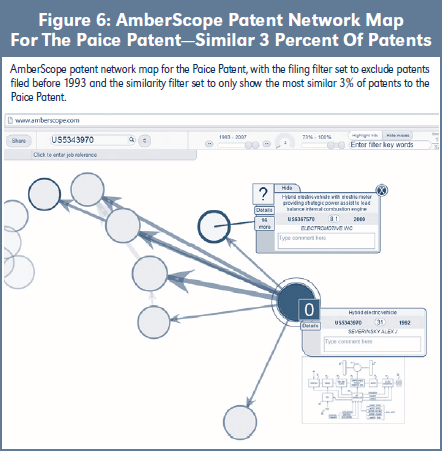
Four of these forward citation patents are also filed by Paice, again a very common finding in citation analysis. The other three patents are US5697466, filed by Equos Research (part of Aisin, affiliated with Toyota), US6367570, filed by Electromotive, and US6116363, filed by the University of California.
This is only illustrative of the process. For example, if the similarity filter is re-set to ‘10’,
i.e. to show the most similar 10 percent of forward citation patents, the 25 most similar patents are shown, as in Figure 7
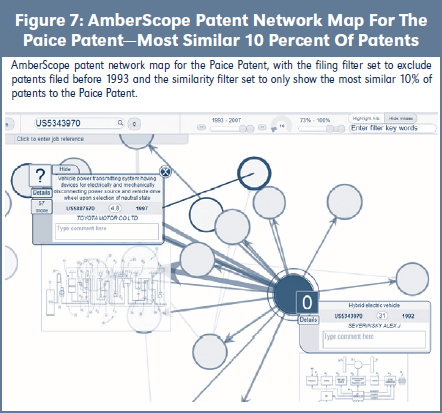
ii. An importance filter.
Ambercite has developed a metric called AmberScore, which is designed to measure the role and impact of a patent in the patent network and so to suggest the relative importance of the patents. AmberScore has been scaled so that the average U.S. patent has an AmberScore value of 1.0—in practice patents with AmberScores above 2 are worth looking at.
The value of AmberScore as a filter for forward citation patents is that higher scoring patents can suggest that its owner applicant is making a large investment into a technology, and in most cases is being recognised by others for doing so. We can use the importance filter to limit patents to the highest scoring patents. In Figure 8, the importance filter has been set to only show the leading 10 percent of the connected patents in combination with the filing filter, again set to exclude patents filed before 1993. Of note, this network of patents includes five patents filed by Aisin or Equos, three patents filed by Ford, three patents filed by Toyota, and two patents filed by General Motors. This analysis shows that the ‘leading’ patents (by AmberScore) for each of these applicants were:
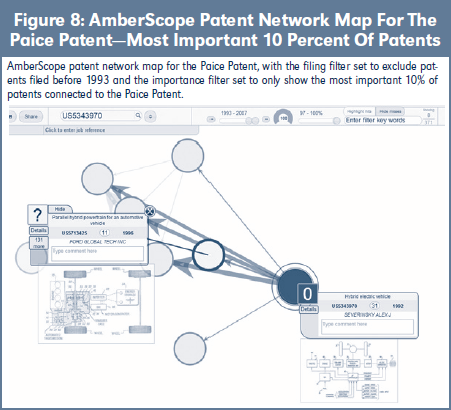
- Aisin or Equos: US5806617, for a Hybrid Vehicle.
- Ford: US5713425, for a Parallel hybrid drivetrain for an automotive vehicle.
- General Motors: US8285432, for a Method and apparatus for developing a control architecture for coordinating shift execution and engine torque control.
- Toyota: US5839533, covering an Apparatus for controlling electric generator of hybrid drive vehicle to control regenerative brake depending upon selected degree of drive source brake application
The value of this list is that it can help uncover the commercial plans of these applicants—along with careful due diligence required for any sort of infringement analysis on the products of a potentially infringing company.
Second Case Study—Two Patents Asserted by Carnegie Mellon Against Marvell
Carnegie Mellon University in 2012 had a 1.13 billion dollar patent judgment against Marvell Semiconductor, a judgment upheld in January 2014. The two patents concerned where US6201839 and US6438180, both covering a method to separate the signal from the noise when reading hard disc drives.
These two patents are closely related, and Espacenet regards them as being in the same patent family. For the purposes of this analysis, I will combine the results from these two patents (hereafter ‘Carnegie Mellon patents’), which is recommended for closely related patents.
a) General statistical review of citations.
Forward citations outnumbered backward citations, with filing activity peaking between 2003 and 2006, Figure 9. Marvell and Quallcom (including acquisition Flarion Technologies) were the leading owners of these patents, Figure 10.
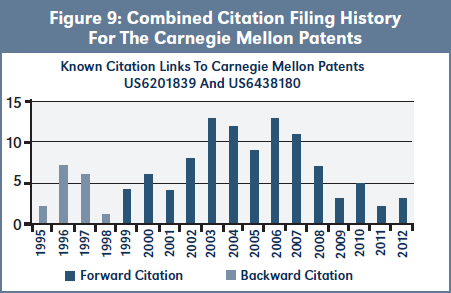
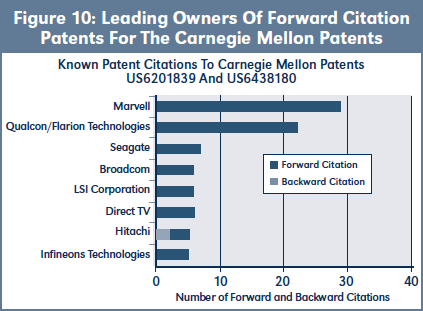
b) Patent River analysis.
Using the exact same process as used with the Paice patent, but looking for forward rejections for both of the Carnegie Mellon patents, we can produce Table 2.
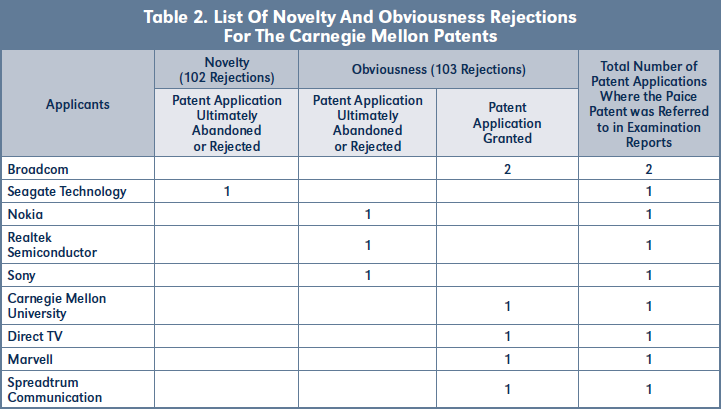
This shows that:
- Broadcom had the Carnegie Mellon patents mentioned in obviousness rejections to two of their patents, but both patents were ultimately granted.
- Seagate had a Carnegie Mellon patent cited (US6438180) against one of its patent applications (US20040268208) in a novelty rejection, and this patent application was ultimately abandoned. This suggests significant similarity between the Carnegie Mellon patent and the Seagate patent application.
- Nokia, Realtek and Sony also had Carnegie Mellon patents cited in an obviousness rejection against patent applications which were ultimately abandoned.
- Marvell, Direct TV and Spreadtrum Communications had one of the Carnegie Mellon patents cited against patents which were ultimately granted.
c) AmberScope analysis.
US6438180 has the most citation links, so we will concentrate on this. An AmberScope network map from this patent is shown in Figure 11. In this map, patents filed by Marvell are highlighted.
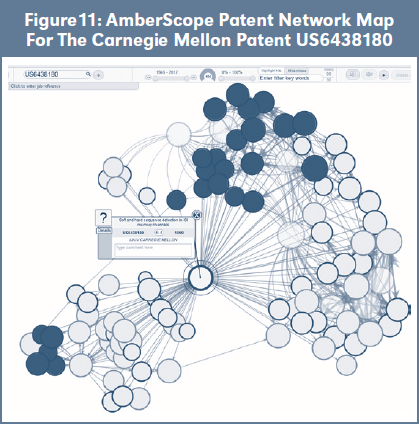
- Most similar forward citation patents.
The three most similar (most similar 4 percent) forward citation patents to US6438180 are shown in Figure 12.
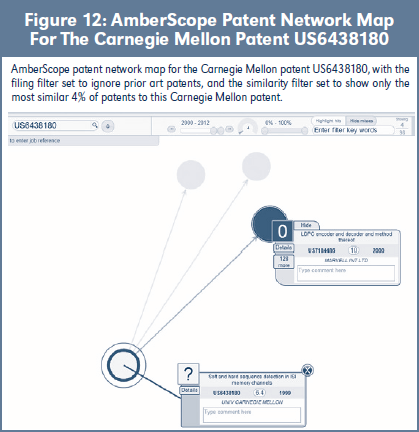
Of note, all three are to Marvell patents, with AmberScope telling us the very most similar patent being US7000177.
Discussion and Conclusions
Before comparing these three sets of results, there is another method many licensing managers use to identify potential licensees—namely scanning the list of the owners of forward citation patents, such as what might be found by reviewing the patent in a suitable patent search website. There is no doubt that in these two examples, that this simple method would have worked. The Paice management would have seen the likes of Ford and Toyota listed as owners of forward citation patents, while the managers of the Carnegie Mellon patents would have seen Qualcomm and Marvel listed as owners of forward citations.
And indeed there is nothing wrong with this, but this assumes a level of knowledge about the industry that the patents belong in. Many licensing managers have good industry knowledge, but not all do for all industries. Also patents may be owned by subsidiaries of large companies where the link to the large company is not immediately obvious. So a more objective approach that is less dependent on industry knowledge can be helpful in some situations.
The next most common approach is the statistical are probably very interested in this area of technology, and probably applications, even if not all of these developments are eventually commercialised.
However the limitation with the ‘look for known applicants’ and the ‘count the patents’ approach is that not all forward citation patents are the same—in both commercial value and the similarity to the patent being licensed. While all of us would inherently understand this, this principle is too often ignored in patent analysis. From a valuation principle, this would be akin to valuing say a portfolio of houses simply on the number of houses in the portfolio.
Many patent analysts do go further and classify the patents being reviewed by the patent classification code applied to the patents. Returning to the real estate analogy, this would be akin to classifying a portfolio of houses by area code. Without doubt, this is a step forward in the valuation model— but a bigger step forward would be to look at the value of the individual houses.
The Patent River approach and the AmberScope approach both look at licensing potential for the forward citation patents being reviewed on an individual basis. The Patent River approach relies on the U.S. patent examiner identifying the specific similarities between the earlier patent and its forward citations in a written examination report. When these similarities are found they can be very powerful pieces of information, especially if the forward citation patent is ultimately rejected on the basis of the earlier patent—which can be strong evidence of similarity. The Patent River approach can also be very helpful where, due to the earlier patent, the later patent application is rejected before grant. In many cases this means that these forward citation links are not formally available as backward citations from un-granted patent applications are not always published. Accordingly, the Patent River approach can find potential licensees where patent citation connections are not formally published.
An alternative approach is to combine all the opinions of all of the examiners in an area of technologies, and effectively triangulate these opinions to identify the most similar, and the likely to be the most important patent. This in turns can potentially identify citation links where the ‘collective wisdom’ of the patent examiners and applicants are suggesting a high degree of similarity—or an important patent which may be a valuable patent. This is the AmberScope approach, and this can be very effective where there is a large number of forward citation patents. Such an approach could be very useful, for example, where the listed owner of a very similar patent is not recognisable as a major company in the area of interest. Identification of these very similar patents can encourage further investigation of these patents, which may uncover opportunities which may be missed by a simple review of listed owners.
It should also be noted that the statistical Patent River and AmberScope approaches are all able to be automated and the results provided in a report suitable for review of a large portfolio—ideal for IP managers responsible for large or new portfolios.
Going Beyond Listed Citations
The Patent River approach can find links to patents where no forward citation links are formally published. The AmberScope approach also allows this type of analysis, on the basis that if a patent A is similar to a patent B based on citations analysis, and patent B is also similar is patent C based on citation analysis, then patent A must also be similar to patent C—even if no formal citation analysis exists. These analyses can be done manually using AmberScope, or via an automated report now available from Ambercite. Further details of this type of analysis are found at the Ambercite website.
Summary
In summary, this paper has considered four different approaches for identifying potential licensees or commercial partners from forward citation data for a patent being reviewed:
- Scanning lists of forward citation patents to take note of owners.
- Identifying the most common owners of forward citation patents.
- The Patent River approach of identifying forward citations where a patent being reviewed is specifically mentioned by the patent examiner.
- The AmberScope approach of identifying the most similar and important forward citation patents.
All of these approaches have their strengths and can have their limitations.
In the two examples shown, these separate analyses have produced a range of results, some overlapping. The observation that they are overlapping to some extent is not surprising and provides some comfort as to their predictive capability. The observation that each approach produces a slightly different set of suggestions for licensing partners suggests that each analysis has its own value. In practice, using all of these techniques is recommended for patent managers looking for the best possible source of information regarding commercial options for their patents.